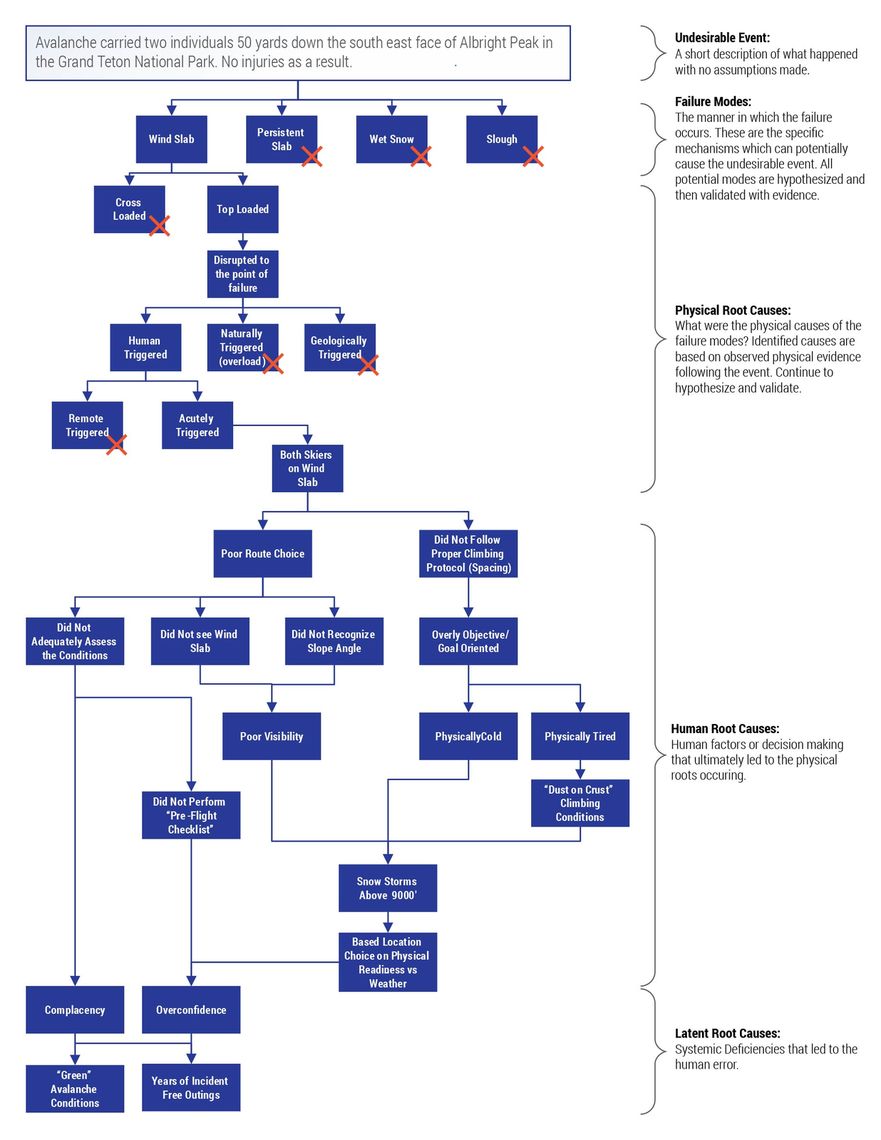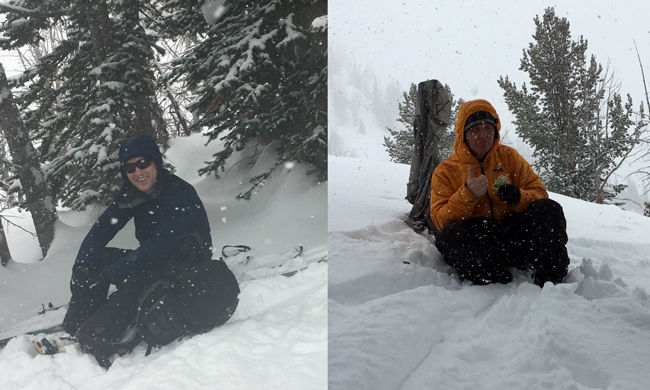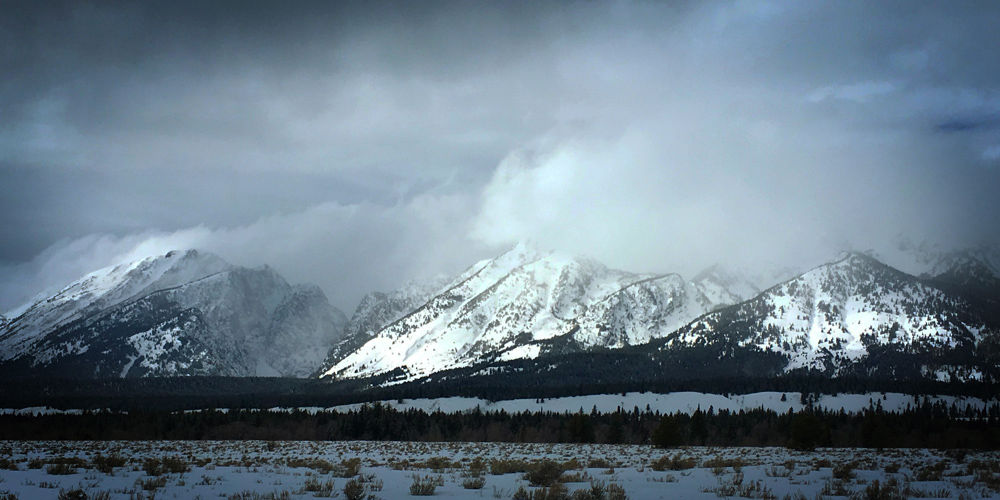Glossary of Terms
(for the non-engineer, non-backcountry folk)
Skin: To climb with skis
Tour: A slightly more formal term for backcountry skiing
Wind-loaded slab: Snow transported from the upwind side of a mountain and deposited on the downwind side
Upwind: Against the direction of the wind
Downwind: In the direction in which the wind is blowing
Persistent slab: Snow built up over time
Loose slough: Loose snow that originates at a single point on a slope and gathers snow on the surface of the pack as it descends
Preflight checklist: A list of tasks that should be performed prior to embarking
Root cause analysis: A method of problem solving used to identify the root cause of those problems
Fishbone diagram: A visualization tool for categorizing the potential causes of a problem
Logic approach: Using a “hypothesize and validate” system to work to the root cause
Failure modes: The physical mechanisms that directly cause the undesirable event
Bottom line: “If you don’t know, don’t go!”
March 17th, 2018, a small avalanche carried me and a friend about 150 feet down the mountain near Jackson, Wyoming. Don’t worry—this story doesn’t end with injuries! Luckily, the depth of the slide was only about 8 inches, so neither of us was buried.
Like many undesirable outcomes, this incident could have been prevented. We both began analyzing and evaluating what we did wrong in the immediate aftermath of the avalanche. As in health care, we wanted to get to the root cause and do our best to adjust our actions to prevent a future incident.
The undesirable event: An avalanche
My plan: skin to the summit of Albright Peak in Grand Teton National Park via the southeast face and ski the same path down the mountain. This particular path was new to us. The total vertical gain of the climb was about 4000 feet.
That day’s weather called for heavy snow in the higher elevations that was expected to taper off around noon. We were somewhat prepared with technology and equipment—our phones directed both ascent and descent routes and we had ski crampons in case there was ice. The southeast-facing slope had frozen to ice overnight with 8-10 inches of light snow. We needed the ski crampons to make the climb, and even then, it was quite rigorous.
Once we reached about 9500 feet (1000 feet below the summit), we ran into heavy snowfall and wind. About 700 feet below the summit, we reached an impasse on the route and had to make a decision. We chose to take the more direct but steeper route.
The visibility had become poor—to the point that I could not see. On the last switchback, I climbed over a heavily wind-loaded area of the slope and it broke underneath my feet. The next thing I remember is my friend yelling “Slide!” I slid down the mountain headfirst towards him. The slide carried us both about 150 feet down that steep section and we came to a stop together where it transitioned to a gentler slope.
Why did this happen? The logic-based approach to root cause analysis
Root cause analysis (RCA) is used to examine why an event occurred. There are several approaches to RCA—here, I’m using the “hypothesize and validate” approach.
For each level in the analysis we hypothesize all of the potential causes. As in the scientific method, we look for evidence to prove or disprove the hypothesis. We eliminate the causes that we cannot validate with evidence. We can work down multiple paths between the event (instead of tracing back to one single event).
Importantly, we look for evidence to validate.

How to conduct a hypothesize and validate root cause analysis
First: Start with the big physical causes.
We identify the failure modes, or the physical mechanisms that directly caused the undesirable event. In this case, there are only four primary mechanisms that can cause an avalanche:
- Wind loading
- Persistent slab (snow built up over time)
- Wet snow
- Loose slough
What mechanism was present? What is the evidence?
In this case, the persistent slab stayed intact during the avalanche. The snow was dry. I saw a clear crown, or break, visible at the top of the slide, which rules out a loose slough. But the location of the slide was “upwind” of the ridgeline, resulting in significant opportunity for wind loading to be present. Once visibility increased, we were able to visually identify the wavy pattern so common in wind-loaded snow. Cross off 2, 3, and 4.
Next: Examine the physical root causes
What physically happened to the snow to result in the avalanche? Again, we are looking for evidence. Referencing the diagram, we can conclude that the eventual physical cause of the slide was that we skinned over top of the wind slab and overloaded it.
Then: Think about the human root causes
Let’s consider human factors and decision-making. This is where the analysis gets interesting. To start, we made a poor choice by deciding to take the steeper, more direct route, not follow proper climbing protocol. That resulted in us both being carried—and could have prevented a rescue should it have been necessary.
The weather was cold and windy, and the climbing conditions were physically grueling. This certainly factored into our decision to take the more direct route. We could have avoided the storm by attempting this route on another day, but we based our decision on the fact that it was our second day in the area and we thought our legs would be fresher.
Additionally, my friend and I are experienced. We have been on roughly 20 tours together and had gotten lazy. In the past, we would discuss the specific challenges of the route and potential risks that we may encounter. Wind loading is almost always part of that discussion, but we didn’t discuss it during this trip.
Last: Consider the latent (cultural) root causes
It would be easy to conclude the analysis with the human factors; however, humans rarely make decisions without some underlying systemic or cultural deficiency. It's true in recreation and it's true in health care.

We were complacent and overconfident. We have been on many tours together, all of which were incident-free. Additionally, the avalanche report was “green” that day, meaning the overall risk was low. My awareness would have been heightened if there had been a warning; however, we don’t always get reminders to be on high alert. Perpetual high alert is not a good plan. Safety needs to be part of the system.
The fix: Corrective action
Corrective actions are most effective when targeted at the latent roots of the event.
The most critical action we will take is the use of the “preflight checklist” on every tour, regardless of the avalanche forecast or the perceived risk of the route. The checklist will focus on reviewing safety equipment, protocol, situational risks of the chosen route, recent avalanche forecasts, and incident reports. It will effectively address the latent root causes of complacency and overconfidence that led to our undesirable event.
Will McNett
Every summer, Utahns head to the mountains for camping, biking, rafting and other activities. And every summer, many a family is left without a stove, or a helmet, or a…because it was left at home. Thrill-seeker and quality manager Cindy Spangler wants to prevent your next packing mishap with a customized camping checklist.
What does it mean to take a system approach to problems? The discipline to learn as a team, patience to wade through hundreds of cases, and a diversity of perspectives. Utah’s Critical Care Senior Nursing Director Colleen Connelly, System Quality, Patient Safety, and Value Senior Director Sandi Gulbransen, and Associate Chief Medical Quality Officer Kencee Graves reflect on what they’ve learned by studying system problems with an interdisciplinary team.
Healthcare isn’t the only industry experiencing whiplash-inducing change. Think about the significant change in the way we travel. We used to hear about a place or a particular hotel from a travel agent or friend, or gasp—the phone book. Today, the number of sites offering advice, recommendations and resources is astounding. In this post, we’re highlighting a few tried and true resources that leverage big data to make travel easier.
